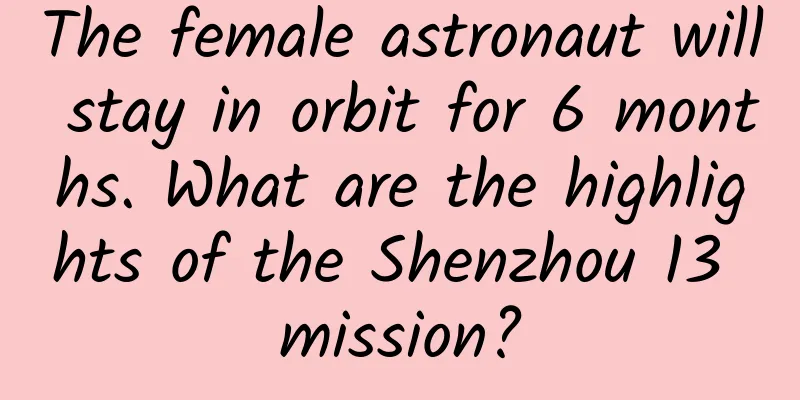The female astronaut will stay in orbit for 6 months. What are the highlights of the Shenzhou 13 mission?

|
The Shenzhou XIII spacecraft was launched in the early morning of October 16, 2021, sending three astronauts, Zhai Zhigang, Wang Yaping and Ye Guangfu, into the Tianhe core module. What is the difference between the Shenzhou XIII mission and what are the highlights of the first female astronaut's spacewalk? The Shenzhou 13 spacecraft was launched from the Jiuquan Satellite Launch Center in the early morning of October 16, 2021, sending three astronauts Zhai Zhigang, Wang Yaping and Ye Guangfu who will carry out the Shenzhou 13 manned flight mission into the "Tianhe" core module of my country's "Tiangong" space station. ▲Zhai Zhigang (center), Wang Yaping (right), and Ye Guangfu (left) are the three astronauts on the Shenzhou 13 manned mission (Photo source: Xinhuanet) This mission is significantly different from the mission of Shenzhou XII. For example, the Shenzhou XIII manned spacecraft uses an autonomous rapid rendezvous and docking method to dock radially at the space station for the first time; by then, the Chinese space station will realize the combined operation of four spacecraft, including the core module, two cargo spacecraft, and one manned spacecraft; astronauts will stay in orbit for six months for the first time; Chinese female astronauts will enter the Chinese space station for the first time, and Wang Yaping will become China's first female astronaut to leave the cabin. The crew of Shenzhou XIII will include China's first male and female astronauts to leave the cabin; on the basis of the Shenzhou XII mission, more space science experiments and technical experiments will be further carried out to produce high-level scientific results; the spacecraft and rockets implementing the mission will directly switch from the emergency standby backup state to the launch state at the launch site. These differences are also the challenges we will face. Come on for China's spaceflight! ▲At 9:58 Beijing time today, astronauts Zhai Zhigang, Wang Yaping and Ye Guangfu entered the Tianhe core module one after another. The Chinese space station also welcomed its second flight crew and its first female astronaut. There are two highlights of this mission: First, the Chinese space station welcomed the first female astronaut and performed extravehicular operations; second, the Shenzhou 13 crew stayed in the "Tianhe" core module for twice as long as the Shenzhou 12 crew, that is, they lived and worked in space for 6 months. This is the first time that Chinese astronauts have stayed in space for such a long time. Therefore, many people will ask, what are the differences in the selection and training of male and female astronauts? What advantages do female astronauts have in space? What challenges will astronauts and spacecraft encounter when they extend their stay in space? The selection and training of male and female astronauts is basically the same Since manned space activities have the characteristics of arduous tasks, complex skills, special environments and high risks, the physiological conditions and psychological qualities of astronauts are very high, otherwise it is difficult to complete the space mission, and female astronauts are no exception. Therefore, the selection and training standards for male and female astronauts are basically the same, and there are no special selection and training standards for female astronauts. It's just that there is an additional gynecological examination when selecting female astronauts, and pregnant astronauts are not allowed. However, due to political and technical factors, the selection criteria for male and female astronauts are sometimes different. For example, the selection criteria for the first batch of female astronauts in the Soviet Union did not completely follow those for male astronauts. At that time, male astronauts were selected from fighter pilots, while the Soviet Union's first female spaceman, Tereshkova, was selected from parachutists. This may be related to the fact that the Soviet Union did not have female fighter pilots at the time, the astronauts needed to parachute before the return capsule returned to the ground, and Tereshkova's good political outlook. After the space station came into being, the tasks performed by astronauts became more and more complicated, so the astronauts were divided into different groups. The flight experts who fly the spacecraft are all selected from fighter pilots, while the mission experts who maintain and repair the spacecraft inside and outside the cabin are not necessarily selected. At present, the number of female astronauts in the world only accounts for 10% of the total number of astronauts, and most of them are mission specialists. This is because there are indeed certain differences between men and women in terms of physiology and psychology. For example, women have more fat, less hemoglobin, shorter average height, lighter weight and lower aerobic exercise capacity. However, the United States and the Soviet Union have different views on the role of female astronauts in manned space activities. For example, after a large number of manned space activities, the United States believes that women are capable of taking on space missions. They are more sensitive, more thoughtful, more comprehensive in considering issues in certain aspects of manned space activities, pay more attention to methods and ways of dealing with problems, and have stronger language expression and communication skills. ▲Sally Reid, the first female astronaut in the United States (Photo source/NASA) In addition, because women are better than men at metabolizing estrogen and magnesium in the weightless environment of space, the iron content and waste production in their bodies are also lower, so they are less likely to have problems such as thrombosis, iron poisoning, vasospasm, and heart rhythm disorders, making them more suitable for long-term manned space flight. Based on these, there have been more and more female astronauts in the United States in the past decade or so. However, the Soviet Union/Russia believed that women were weak and had poor physical strength, and could hardly endure the harsh environment of space flight and complete heavy physical work such as spacewalks. Therefore, to date, only four female astronauts from the Soviet Union/Russia have gone into space, and they did so mainly for political purposes, to become the world's number one in space flight. However, Russia is changing its view on female astronauts. The Russian Cosmonaut Corps currently has 29 astronauts, one of whom is a woman named Kikina. She is expected to break the national record for women staying in space in 2023 and stay on duty at the International Space Station for 188 days. The original record was set by Kondakova, but she has accumulated two times for a total of 178 days. The current world record for women staying in space continuously is set by American female astronaut Koch, who has a time of 328 days; the world record for women staying in space cumulatively is set by American female astronaut Whitson, who has accumulated three times for a total of 666 days. ▲Russian female astronaut Anna Kikina may break the national record of women staying in space in 2023 (Photo source/NASA) my country's female astronauts' space mission my country's first two female astronauts were selected from married, non-pregnant transport aircraft pilots in 2010. There are two main reasons for this: first, their physical and mental qualities are more mature; second, their time spent flying airplanes meets the selection criteria for astronauts, and therefore they have more experience. If a married female astronaut goes to space, she is generally required to give birth naturally rather than by caesarean section, in order to avoid scarring. Because during space flight, there may be low pressure, which can cause scars to open due to the high pressure of the human body. ▲China's first female astronaut Liu Yang (Photo source/NASA) ▲Wang Yaping on the Shenzhou 13 manned mission (Photo source: Xinhuanet) The selection of female astronaut Wang Yaping as a member of the crew may be due to the following considerations: First, the Shenzhou 13 crew is the first Chinese spacecraft to carry out a long-term stay of six months, so it will have a greater impact on the astronauts' physiology and psychology. Research and practice have shown that in terms of physiological structure and psychological quality, women have a more lasting ability to adapt to the space environment, have a stronger ability to endure loneliness, and have a more stable psychological quality. Second, female astronauts can bring vitality to the crew. When men and women work together, both sides can coordinate smoothly, be proactive, work efficiently and make fewer mistakes. This is what is called "men and women working together makes work less tiring." Third, women's space travel is also conducive to the comprehensive development of medical research. Without women's participation in manned space flight, the research results of space life sciences will be incomplete. Fourth, female astronaut Wang Yaping has been to space once, so she is more experienced. Of course, some special preparations are also needed to meet the physiological characteristics and life needs of female astronauts. For example, the seats used by female astronauts on the spacecraft are tailor-made, so that the impact of overweight and vibration during launch and return is smaller; a set of space suits for female astronauts is equipped, and female gloves are specially made for female astronauts' hands, especially because women have slender fingers; the height and relative position of the urine and feces collector are also partially modified, and a female-specific adapter is provided; chocolate, sweets and blood-enriching foods are prepared to meet the needs of female astronauts. It is worth noting that the Tianzhou 3, which was launched into space earlier, delivered an extravehicular space suit suitable for the body shape of female astronaut Wang Yaping and other replacement clothes, as well as sanitary products, cosmetics, etc. It can be seen that this time it is possible to let female astronaut Wang Yaping perform the first female spacewalk mission in my country, thus giving birth to the first Chinese female spacewalker and exploring the experience of female spacewalk. Female astronauts are small in stature, which is also an advantage in some ways, that is, it is easier to control the body after leaving the cabin and do some delicate work more flexibly. American female astronaut Helms once set the world record for the longest spacewalk of 8 hours and 56 minutes with male astronaut Voss. In addition, it is also important to send an extravehicular space suit suitable for the body of female astronaut Wang Yaping by cargo spacecraft. In terms of overall design, the performance of the female-specific extravehicular space suit is the same as that of other second-generation "Feitian" extravehicular space suits, but the size is specially designed according to the body of female astronaut Wang Yaping, so it is more fitted, flexible when going out of the cabin, can reduce physical exertion and improve work efficiency. One of the important reasons why there are few female astronauts going out of the cabin abroad is that there are no special extravehicular space suits for women. Universal extravehicular space suits are generally larger and cannot be worn by female astronauts. The United States postponed the world's first all-female spacewalk because of the lack of an extravehicular space suit suitable for women. The impact of long time in orbit This time, my country's astronaut crew and the Shenzhou spacecraft will stay in orbit for six consecutive months for the first time. What impact will this have on the astronauts, the space station and the spacecraft? The experience of foreign astronauts staying in space for a long time shows that the longer they live and work in the space station, the greater the impact of the space environment on people's physical and psychological health. For example, in terms of physiology, long-term life in space will cause astronauts' bone decalcification and muscle atrophy. Because of the influence of the microgravity environment, the pressure acting on the body's load-bearing bones decreases suddenly. At the same time, muscle movement decreases, the stimulation to the bones is correspondingly weakened, and the blood supply to the bones is also reduced accordingly. These will cause bone decalcification and excretion through the kidneys, resulting in severe bone loss. Therefore, astronauts are prone to fractures, and the calcium content in body fluids increases, which in turn causes kidney stones and soft tissue calcification. In addition, the reduction of muscle movement will also cause the astronauts' muscles to become disused, that is, atrophy. The longer the flight time, the more serious the muscle atrophy. Therefore, after returning to the ground, astronauts often feel weak all over, and it is difficult to stand or walk. To this end, the current countermeasures are: first, strengthen exercise, use power bicycles, treadmills, pullers and other equipment to exercise for 2 hours every day, including upper and lower limbs and other parts of the body; second, often wear penguin suits, which can force people to do any activity very strenuously; third, use lower body negative pressure devices to make people's body fluids flow downward; fourth, take special medicines, replenish water and salt, and strengthen nutrition and vitamins; fifth, conduct electrical stimulation of muscles, and use "space massagers" to assist astronauts in muscle fatigue recovery and muscle strength training; sixth, conduct pre-flight adaptation training; seventh, astronauts should be carried on chairs when leaving the cabin on the ground, and do not hug each other. Eighth, conduct scientific restorative recuperation. The extended stay in orbit also has a significant impact on the astronauts' psychology. For example, one astronaut in the Mir crew experienced a personality change and started quarreling after living and working in space for a year. Therefore, in astronaut training, psychological training runs through the entire training process. Psychological training is to cultivate astronauts' good professional personality and psychological quality, and lay a good psychological foundation for long-term stay in space. It includes: mental health education; relaxation training; imagery training; psychological compatibility training; small environment adaptability training, etc. Among them, imagery training is to make astronauts imagine certain operating methods, processes, essentials, and emergency measures; the purpose of psychological compatibility training is to master the skills of communicating with people, learn to ease interpersonal relationships, and eliminate friction. ▲ Tang Hongbo, an astronaut on the Shenzhou XII manned mission, is relaxing on China's brand new space station - and the living facilities are "surprisingly luxurious". The astronaut seems to have posted the operating manual, headphones and photos of his family on the walls of his spacious bedroom, and the bedroom even has a "private" window for him to watch the scenery outside the cabin. (Photo source/Xinhuanet) In the selection of astronaut crews, psychological compatibility is an important factor to consider. This time, there are female astronauts in the Shenzhou 13 crew, so it has a certain effect on the psychological adjustment of the crew. After going into space, astronauts can also use psychological relaxation systems, listen to music, watch TV and other methods to adjust their psychology, or communicate with psychologists and family members on the ground. At present, the long-term exploration team on the International Space Station is also rotated every six months. This is considered to be a relatively appropriate time, considering the physiological and psychological impact of the space environment on astronauts and the cost of launching manned spacecraft. Starting from the second batch of crew members, my country's astronaut crews will be rotated every six months. Written by Pang Zhihao (Chief Scientific Communication Expert of National Space Exploration Technology) Graphic editor/Chen Yongjie New media editor/Lv Bingxin Produced by: Science Central Kitchen Produced by: Beijing Science and Technology News | Science Plus Client Welcome to share to your circle of friends |
>>: This article shows you Matsutake mushrooms from around the world
Recommend
Guangdiantong optimization tips and precautions
Guangdiantong is a DSP advertisement based on Ten...
Official review of "10 years of WeChat": the original interface looked like this, full of memories
WeChat was officially launched on January 21, 201...
Event planning and promotion process!
When talking about the "crash" experien...
The dilemma facing mobile phone manufacturers in 2019: 5G is coming, should they follow suit or not?
In the mobile phone industry, the battle for 5G i...
IEA: Path to a new era of nuclear energy
The IEA has released a new report, “The Road to a...
Soul competitive product analysis!
Socializing with strangers is something that many...
Why can't we feel the earth spinning?
Regarding rotation, it's not that simple. By ...
Useful information | A guide to Weibo Fans Channel placement in the education industry!
The online education industry is booming, and mar...
Platform-based brand marketing strategy!
There are huge differences in brand marketing bet...
YaYaYa! The 280th Danxia flyer turned out to be this one!
Danxia bird season is here, and the Guangdong Dan...
"Fruity Robo" TV version review: a cute and silly game
Games adapted from anime IPs have always been an ...
Activity review: fission poster activity promotion strategy
Without further ado, let’s get straight to the po...
Google officially releases Android P fifth developer preview update
Early this morning, Google officially launched th...
What? I've been picking pine cones for so many years, and you tell me it's not a fruit?
There is a "pine cone tower" hanging ne...
5 easy-to-use data visualization platforms to make your data analysis more efficient and high-end
The effect is amazing! Make your friends envious ...









